Early Childhood Care (CHCECE007) Case Study: Scenarios and Questions
VerifiedAdded on 2022/12/28
|11
|3121
|68
Case Study
AI Summary
This case study assignment, focusing on the CHCECE007 unit, explores various scenarios and questions related to early childhood care and education. The assignment addresses critical aspects such as handling conflicts between children, promoting positive communication and behaviour, and ensuring safety within a childcare setting. It delves into the importance of language styles, effective verbal and non-verbal communication strategies, and the role of childcare staff in fostering a supportive and inclusive environment. The study examines the impact of biological and behavioural factors on child development, emphasizing the significance of praise, encouragement, and consistent guidelines. Furthermore, it provides insights into building trust and creating a positive atmosphere for children within the childcare setting. This assignment, contributed by a student, offers valuable insights and solutions for educators and childcare professionals, and is available on Desklib, a platform providing AI-powered study tools.
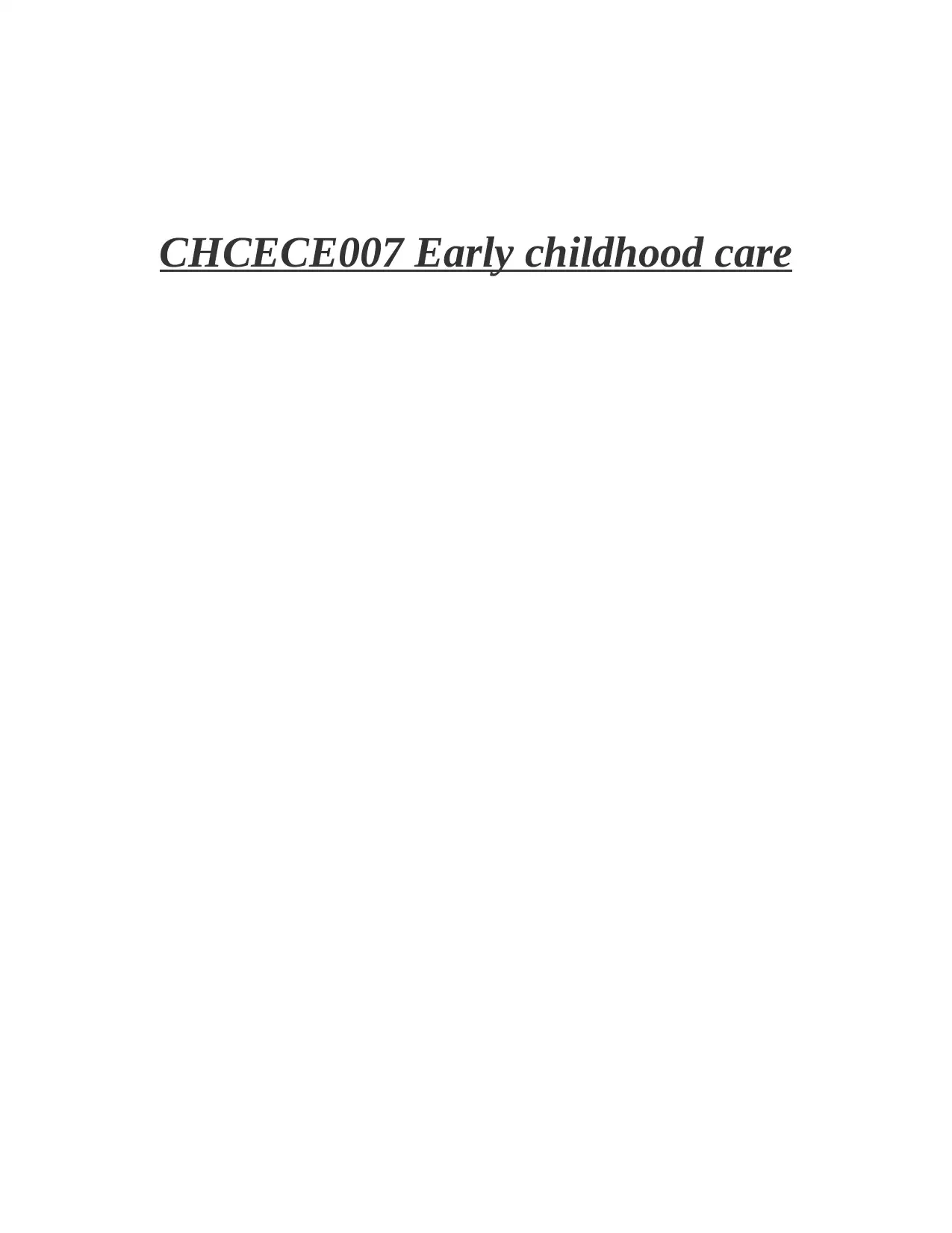
CHCECE007 Early childhood care
Paraphrase This Document
Need a fresh take? Get an instant paraphrase of this document with our AI Paraphraser
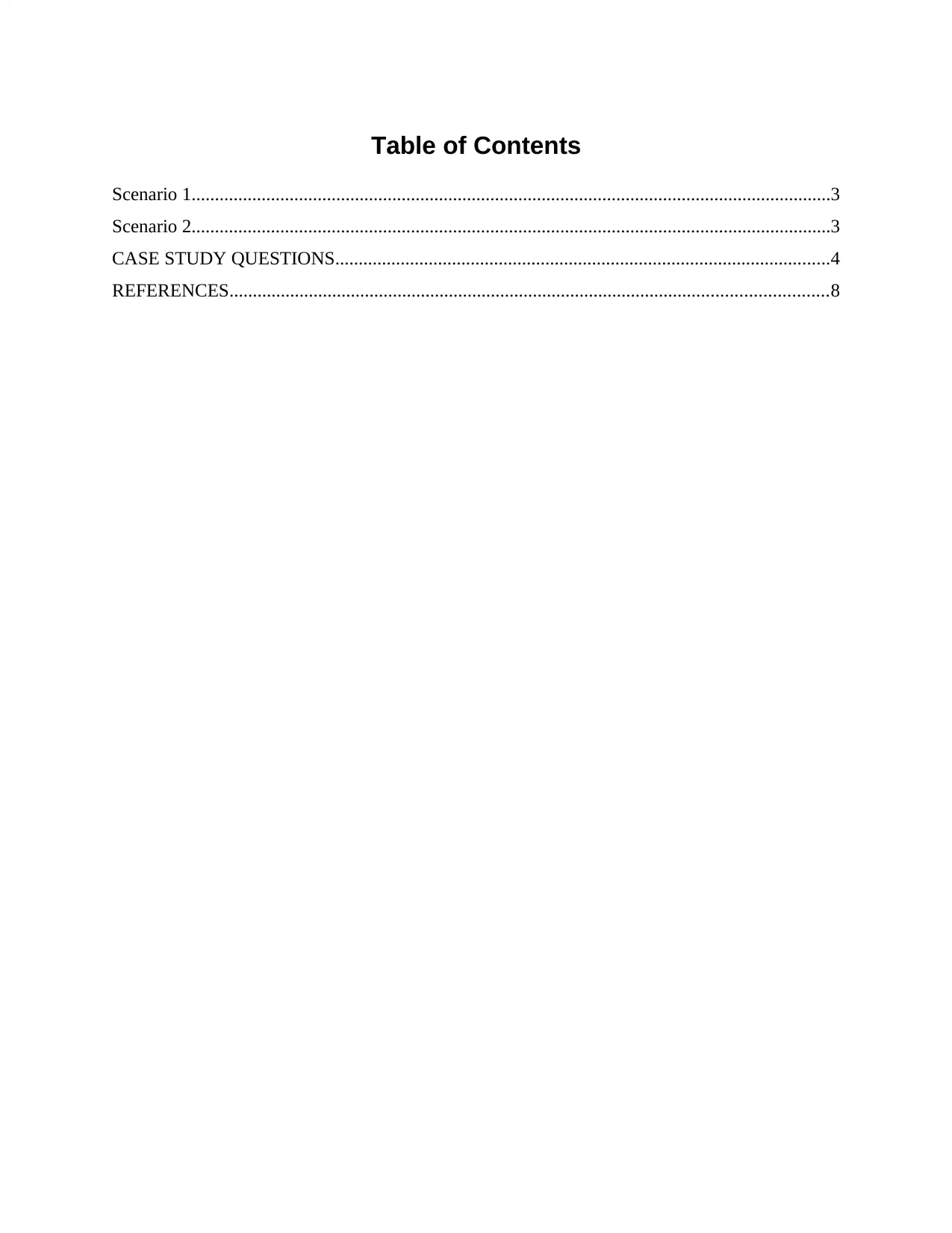
Table of Contents
Scenario 1.........................................................................................................................................3
Scenario 2.........................................................................................................................................3
CASE STUDY QUESTIONS..........................................................................................................4
REFERENCES................................................................................................................................8
Scenario 1.........................................................................................................................................3
Scenario 2.........................................................................................................................................3
CASE STUDY QUESTIONS..........................................................................................................4
REFERENCES................................................................................................................................8
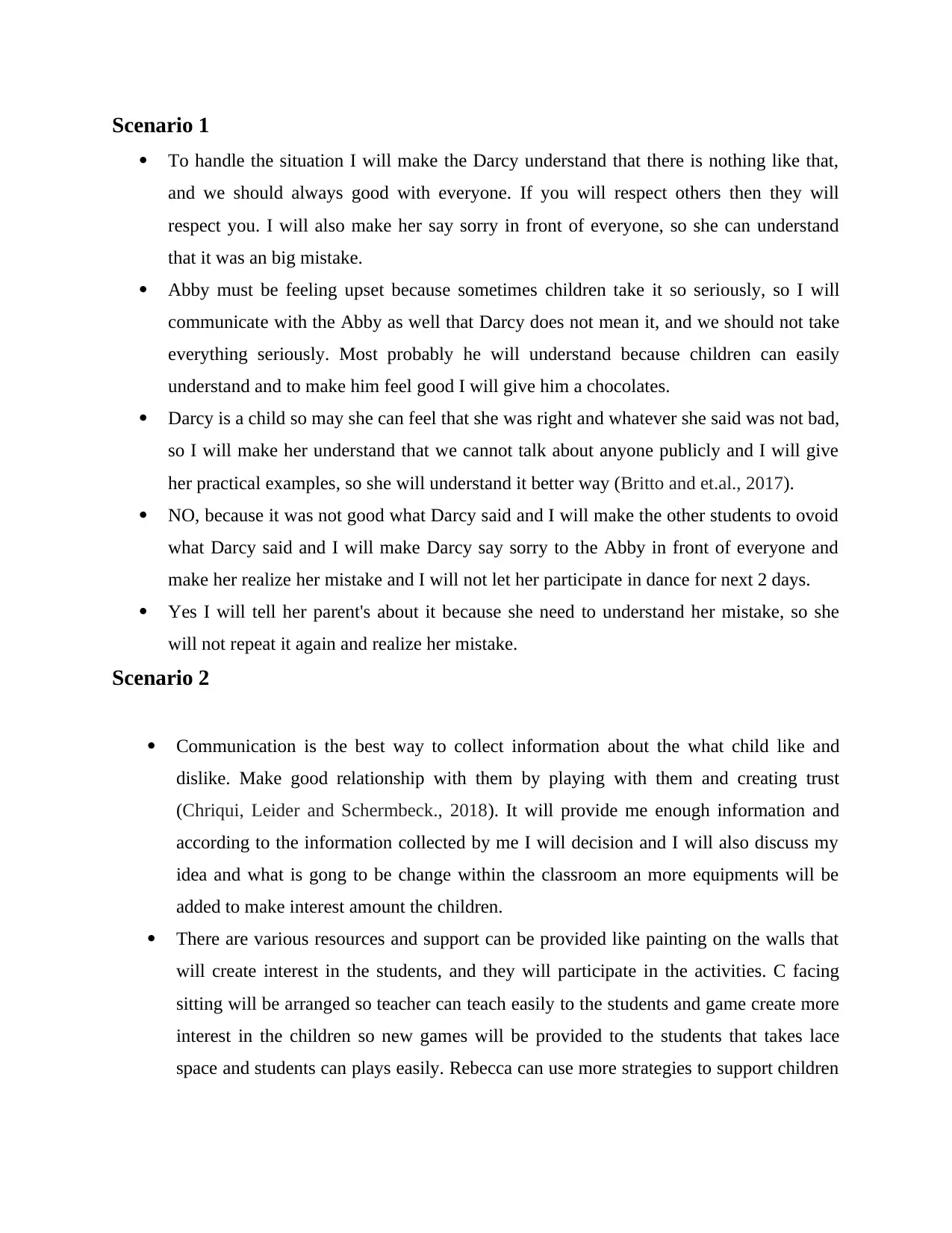
Scenario 1
To handle the situation I will make the Darcy understand that there is nothing like that,
and we should always good with everyone. If you will respect others then they will
respect you. I will also make her say sorry in front of everyone, so she can understand
that it was an big mistake.
Abby must be feeling upset because sometimes children take it so seriously, so I will
communicate with the Abby as well that Darcy does not mean it, and we should not take
everything seriously. Most probably he will understand because children can easily
understand and to make him feel good I will give him a chocolates.
Darcy is a child so may she can feel that she was right and whatever she said was not bad,
so I will make her understand that we cannot talk about anyone publicly and I will give
her practical examples, so she will understand it better way (Britto and et.al., 2017).
NO, because it was not good what Darcy said and I will make the other students to ovoid
what Darcy said and I will make Darcy say sorry to the Abby in front of everyone and
make her realize her mistake and I will not let her participate in dance for next 2 days.
Yes I will tell her parent's about it because she need to understand her mistake, so she
will not repeat it again and realize her mistake.
Scenario 2
Communication is the best way to collect information about the what child like and
dislike. Make good relationship with them by playing with them and creating trust
(Chriqui, Leider and Schermbeck., 2018). It will provide me enough information and
according to the information collected by me I will decision and I will also discuss my
idea and what is gong to be change within the classroom an more equipments will be
added to make interest amount the children.
There are various resources and support can be provided like painting on the walls that
will create interest in the students, and they will participate in the activities. C facing
sitting will be arranged so teacher can teach easily to the students and game create more
interest in the children so new games will be provided to the students that takes lace
space and students can plays easily. Rebecca can use more strategies to support children
To handle the situation I will make the Darcy understand that there is nothing like that,
and we should always good with everyone. If you will respect others then they will
respect you. I will also make her say sorry in front of everyone, so she can understand
that it was an big mistake.
Abby must be feeling upset because sometimes children take it so seriously, so I will
communicate with the Abby as well that Darcy does not mean it, and we should not take
everything seriously. Most probably he will understand because children can easily
understand and to make him feel good I will give him a chocolates.
Darcy is a child so may she can feel that she was right and whatever she said was not bad,
so I will make her understand that we cannot talk about anyone publicly and I will give
her practical examples, so she will understand it better way (Britto and et.al., 2017).
NO, because it was not good what Darcy said and I will make the other students to ovoid
what Darcy said and I will make Darcy say sorry to the Abby in front of everyone and
make her realize her mistake and I will not let her participate in dance for next 2 days.
Yes I will tell her parent's about it because she need to understand her mistake, so she
will not repeat it again and realize her mistake.
Scenario 2
Communication is the best way to collect information about the what child like and
dislike. Make good relationship with them by playing with them and creating trust
(Chriqui, Leider and Schermbeck., 2018). It will provide me enough information and
according to the information collected by me I will decision and I will also discuss my
idea and what is gong to be change within the classroom an more equipments will be
added to make interest amount the children.
There are various resources and support can be provided like painting on the walls that
will create interest in the students, and they will participate in the activities. C facing
sitting will be arranged so teacher can teach easily to the students and game create more
interest in the children so new games will be provided to the students that takes lace
space and students can plays easily. Rebecca can use more strategies to support children
⊘ This is a preview!⊘
Do you want full access?
Subscribe today to unlock all pages.

Trusted by 1+ million students worldwide
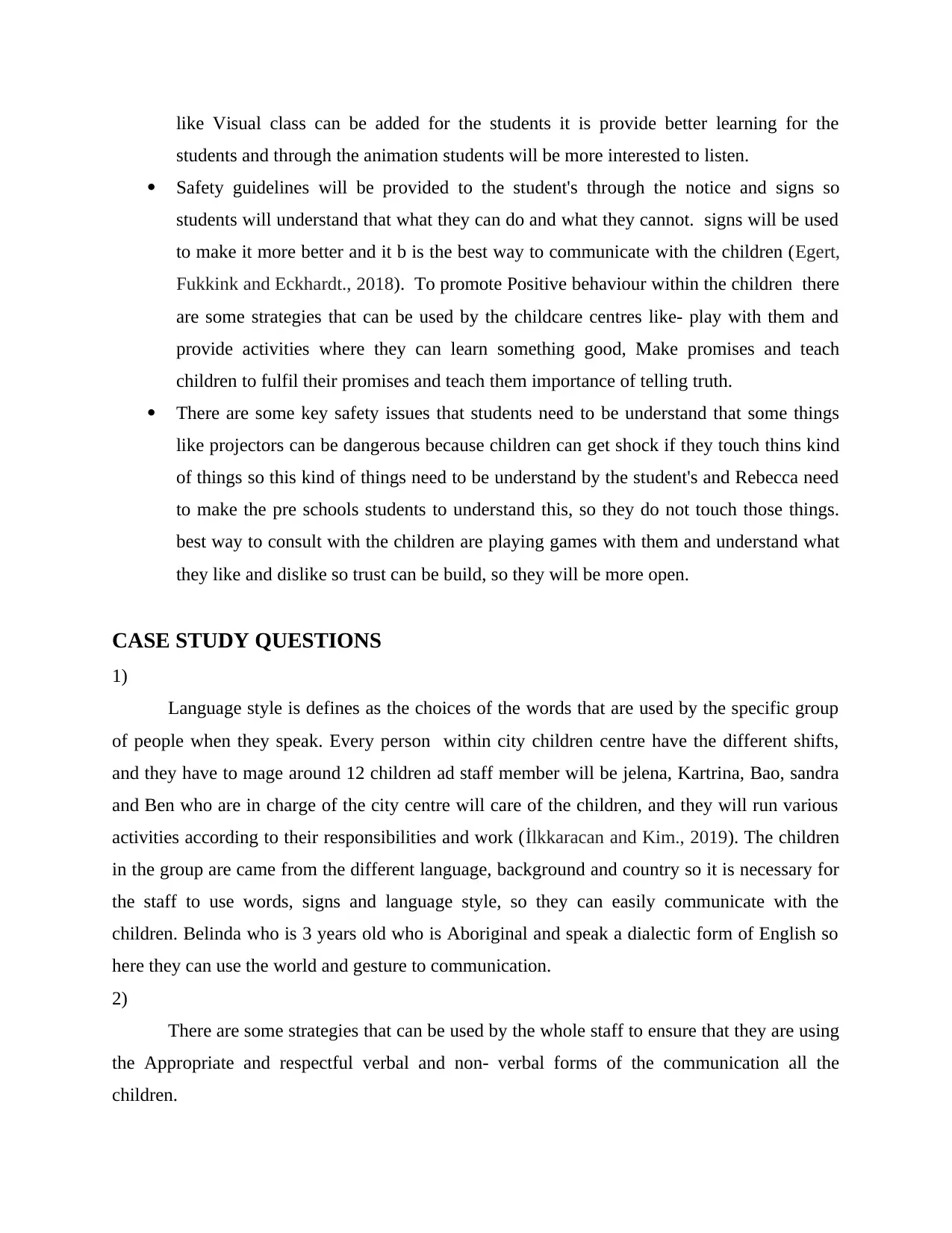
like Visual class can be added for the students it is provide better learning for the
students and through the animation students will be more interested to listen.
Safety guidelines will be provided to the student's through the notice and signs so
students will understand that what they can do and what they cannot. signs will be used
to make it more better and it b is the best way to communicate with the children (Egert,
Fukkink and Eckhardt., 2018). To promote Positive behaviour within the children there
are some strategies that can be used by the childcare centres like- play with them and
provide activities where they can learn something good, Make promises and teach
children to fulfil their promises and teach them importance of telling truth.
There are some key safety issues that students need to be understand that some things
like projectors can be dangerous because children can get shock if they touch thins kind
of things so this kind of things need to be understand by the student's and Rebecca need
to make the pre schools students to understand this, so they do not touch those things.
best way to consult with the children are playing games with them and understand what
they like and dislike so trust can be build, so they will be more open.
CASE STUDY QUESTIONS
1)
Language style is defines as the choices of the words that are used by the specific group
of people when they speak. Every person within city children centre have the different shifts,
and they have to mage around 12 children ad staff member will be jelena, Kartrina, Bao, sandra
and Ben who are in charge of the city centre will care of the children, and they will run various
activities according to their responsibilities and work (İlkkaracan and Kim., 2019). The children
in the group are came from the different language, background and country so it is necessary for
the staff to use words, signs and language style, so they can easily communicate with the
children. Belinda who is 3 years old who is Aboriginal and speak a dialectic form of English so
here they can use the world and gesture to communication.
2)
There are some strategies that can be used by the whole staff to ensure that they are using
the Appropriate and respectful verbal and non- verbal forms of the communication all the
children.
students and through the animation students will be more interested to listen.
Safety guidelines will be provided to the student's through the notice and signs so
students will understand that what they can do and what they cannot. signs will be used
to make it more better and it b is the best way to communicate with the children (Egert,
Fukkink and Eckhardt., 2018). To promote Positive behaviour within the children there
are some strategies that can be used by the childcare centres like- play with them and
provide activities where they can learn something good, Make promises and teach
children to fulfil their promises and teach them importance of telling truth.
There are some key safety issues that students need to be understand that some things
like projectors can be dangerous because children can get shock if they touch thins kind
of things so this kind of things need to be understand by the student's and Rebecca need
to make the pre schools students to understand this, so they do not touch those things.
best way to consult with the children are playing games with them and understand what
they like and dislike so trust can be build, so they will be more open.
CASE STUDY QUESTIONS
1)
Language style is defines as the choices of the words that are used by the specific group
of people when they speak. Every person within city children centre have the different shifts,
and they have to mage around 12 children ad staff member will be jelena, Kartrina, Bao, sandra
and Ben who are in charge of the city centre will care of the children, and they will run various
activities according to their responsibilities and work (İlkkaracan and Kim., 2019). The children
in the group are came from the different language, background and country so it is necessary for
the staff to use words, signs and language style, so they can easily communicate with the
children. Belinda who is 3 years old who is Aboriginal and speak a dialectic form of English so
here they can use the world and gesture to communication.
2)
There are some strategies that can be used by the whole staff to ensure that they are using
the Appropriate and respectful verbal and non- verbal forms of the communication all the
children.
Paraphrase This Document
Need a fresh take? Get an instant paraphrase of this document with our AI Paraphraser
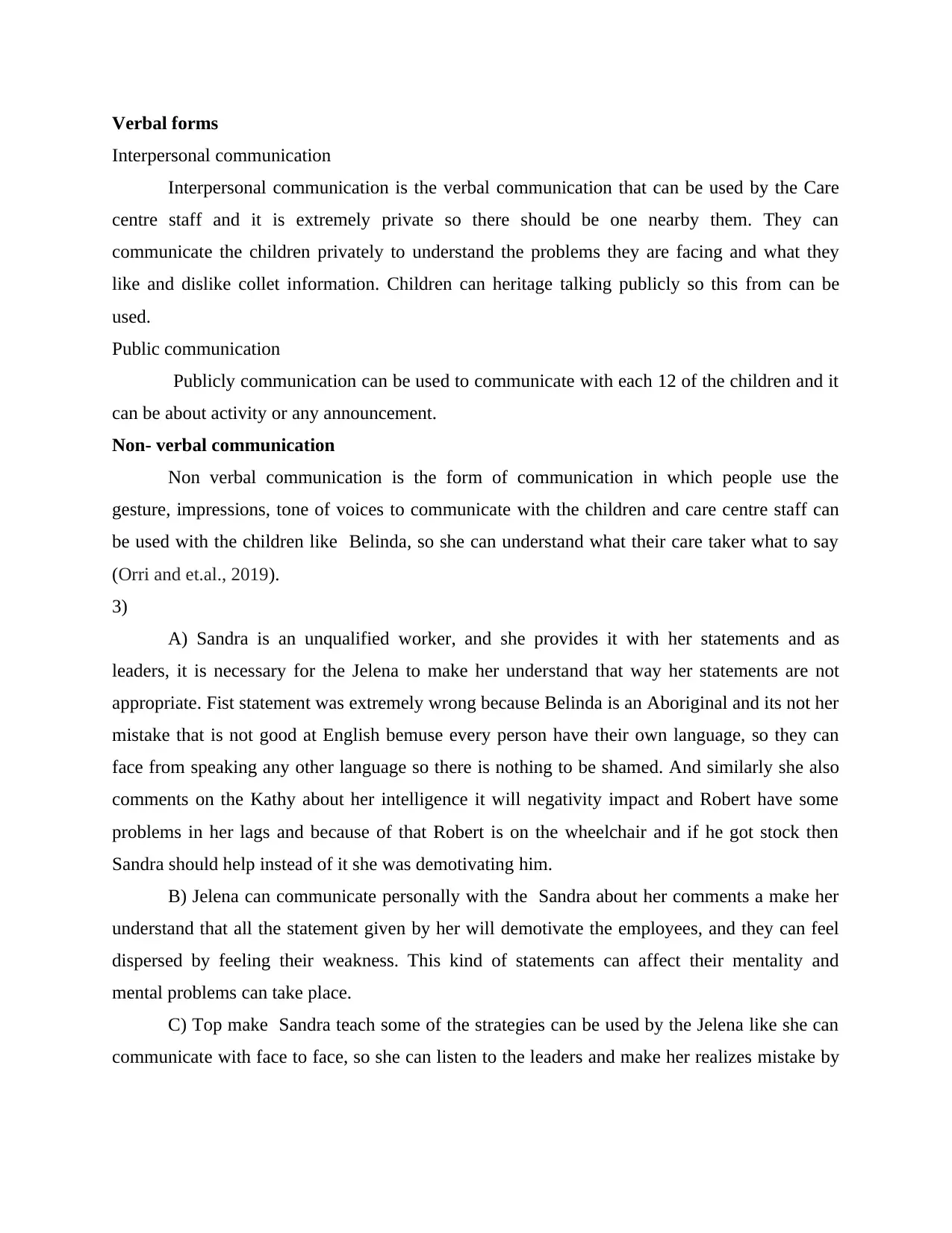
Verbal forms
Interpersonal communication
Interpersonal communication is the verbal communication that can be used by the Care
centre staff and it is extremely private so there should be one nearby them. They can
communicate the children privately to understand the problems they are facing and what they
like and dislike collet information. Children can heritage talking publicly so this from can be
used.
Public communication
Publicly communication can be used to communicate with each 12 of the children and it
can be about activity or any announcement.
Non- verbal communication
Non verbal communication is the form of communication in which people use the
gesture, impressions, tone of voices to communicate with the children and care centre staff can
be used with the children like Belinda, so she can understand what their care taker what to say
(Orri and et.al., 2019).
3)
A) Sandra is an unqualified worker, and she provides it with her statements and as
leaders, it is necessary for the Jelena to make her understand that way her statements are not
appropriate. Fist statement was extremely wrong because Belinda is an Aboriginal and its not her
mistake that is not good at English bemuse every person have their own language, so they can
face from speaking any other language so there is nothing to be shamed. And similarly she also
comments on the Kathy about her intelligence it will negativity impact and Robert have some
problems in her lags and because of that Robert is on the wheelchair and if he got stock then
Sandra should help instead of it she was demotivating him.
B) Jelena can communicate personally with the Sandra about her comments a make her
understand that all the statement given by her will demotivate the employees, and they can feel
dispersed by feeling their weakness. This kind of statements can affect their mentality and
mental problems can take place.
C) Top make Sandra teach some of the strategies can be used by the Jelena like she can
communicate with face to face, so she can listen to the leaders and make her realizes mistake by
Interpersonal communication
Interpersonal communication is the verbal communication that can be used by the Care
centre staff and it is extremely private so there should be one nearby them. They can
communicate the children privately to understand the problems they are facing and what they
like and dislike collet information. Children can heritage talking publicly so this from can be
used.
Public communication
Publicly communication can be used to communicate with each 12 of the children and it
can be about activity or any announcement.
Non- verbal communication
Non verbal communication is the form of communication in which people use the
gesture, impressions, tone of voices to communicate with the children and care centre staff can
be used with the children like Belinda, so she can understand what their care taker what to say
(Orri and et.al., 2019).
3)
A) Sandra is an unqualified worker, and she provides it with her statements and as
leaders, it is necessary for the Jelena to make her understand that way her statements are not
appropriate. Fist statement was extremely wrong because Belinda is an Aboriginal and its not her
mistake that is not good at English bemuse every person have their own language, so they can
face from speaking any other language so there is nothing to be shamed. And similarly she also
comments on the Kathy about her intelligence it will negativity impact and Robert have some
problems in her lags and because of that Robert is on the wheelchair and if he got stock then
Sandra should help instead of it she was demotivating him.
B) Jelena can communicate personally with the Sandra about her comments a make her
understand that all the statement given by her will demotivate the employees, and they can feel
dispersed by feeling their weakness. This kind of statements can affect their mentality and
mental problems can take place.
C) Top make Sandra teach some of the strategies can be used by the Jelena like she can
communicate with face to face, so she can listen to the leaders and make her realizes mistake by
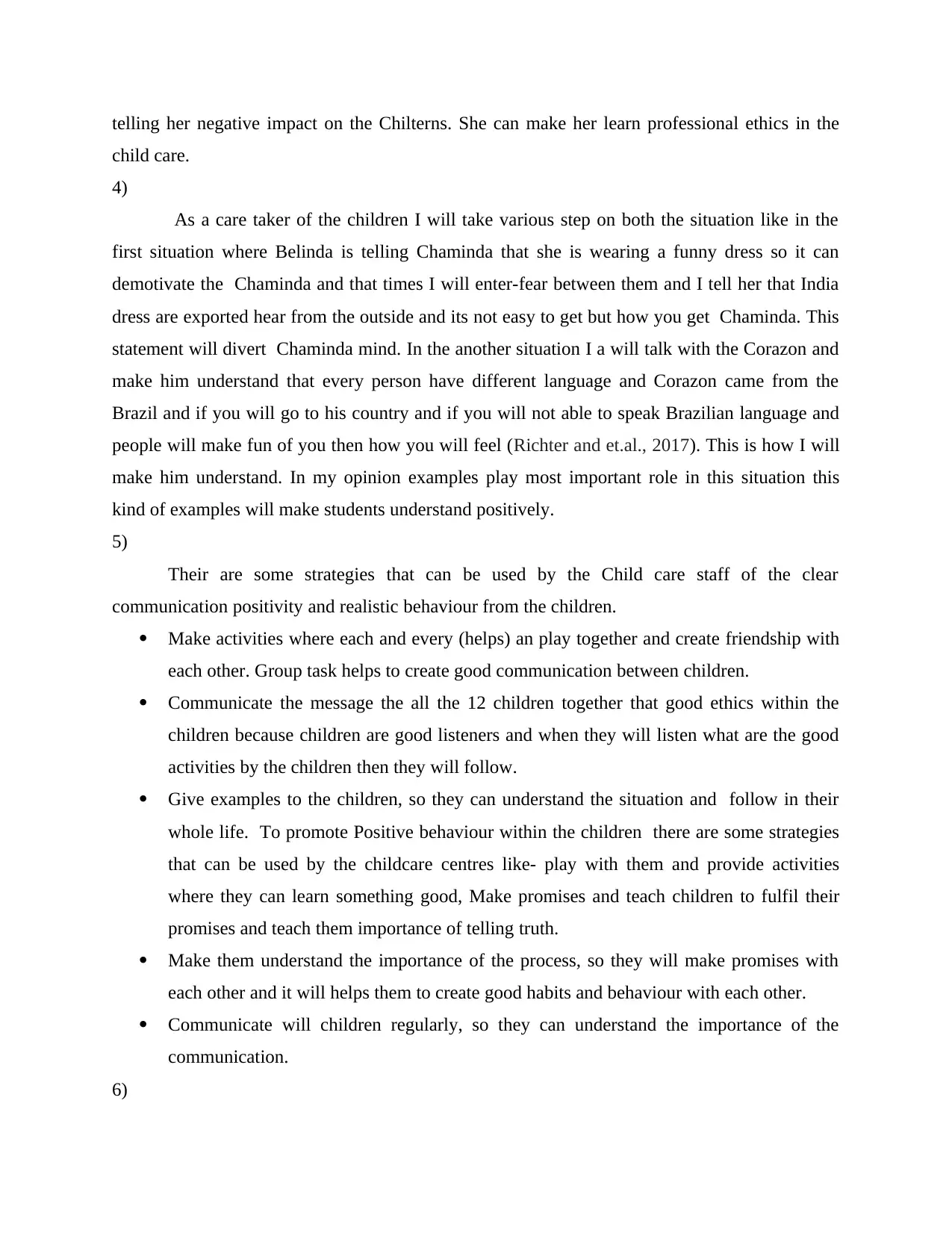
telling her negative impact on the Chilterns. She can make her learn professional ethics in the
child care.
4)
As a care taker of the children I will take various step on both the situation like in the
first situation where Belinda is telling Chaminda that she is wearing a funny dress so it can
demotivate the Chaminda and that times I will enter-fear between them and I tell her that India
dress are exported hear from the outside and its not easy to get but how you get Chaminda. This
statement will divert Chaminda mind. In the another situation I a will talk with the Corazon and
make him understand that every person have different language and Corazon came from the
Brazil and if you will go to his country and if you will not able to speak Brazilian language and
people will make fun of you then how you will feel (Richter and et.al., 2017). This is how I will
make him understand. In my opinion examples play most important role in this situation this
kind of examples will make students understand positively.
5)
Their are some strategies that can be used by the Child care staff of the clear
communication positivity and realistic behaviour from the children.
Make activities where each and every (helps) an play together and create friendship with
each other. Group task helps to create good communication between children.
Communicate the message the all the 12 children together that good ethics within the
children because children are good listeners and when they will listen what are the good
activities by the children then they will follow.
Give examples to the children, so they can understand the situation and follow in their
whole life. To promote Positive behaviour within the children there are some strategies
that can be used by the childcare centres like- play with them and provide activities
where they can learn something good, Make promises and teach children to fulfil their
promises and teach them importance of telling truth.
Make them understand the importance of the process, so they will make promises with
each other and it will helps them to create good habits and behaviour with each other.
Communicate will children regularly, so they can understand the importance of the
communication.
6)
child care.
4)
As a care taker of the children I will take various step on both the situation like in the
first situation where Belinda is telling Chaminda that she is wearing a funny dress so it can
demotivate the Chaminda and that times I will enter-fear between them and I tell her that India
dress are exported hear from the outside and its not easy to get but how you get Chaminda. This
statement will divert Chaminda mind. In the another situation I a will talk with the Corazon and
make him understand that every person have different language and Corazon came from the
Brazil and if you will go to his country and if you will not able to speak Brazilian language and
people will make fun of you then how you will feel (Richter and et.al., 2017). This is how I will
make him understand. In my opinion examples play most important role in this situation this
kind of examples will make students understand positively.
5)
Their are some strategies that can be used by the Child care staff of the clear
communication positivity and realistic behaviour from the children.
Make activities where each and every (helps) an play together and create friendship with
each other. Group task helps to create good communication between children.
Communicate the message the all the 12 children together that good ethics within the
children because children are good listeners and when they will listen what are the good
activities by the children then they will follow.
Give examples to the children, so they can understand the situation and follow in their
whole life. To promote Positive behaviour within the children there are some strategies
that can be used by the childcare centres like- play with them and provide activities
where they can learn something good, Make promises and teach children to fulfil their
promises and teach them importance of telling truth.
Make them understand the importance of the process, so they will make promises with
each other and it will helps them to create good habits and behaviour with each other.
Communicate will children regularly, so they can understand the importance of the
communication.
6)
⊘ This is a preview!⊘
Do you want full access?
Subscribe today to unlock all pages.

Trusted by 1+ million students worldwide
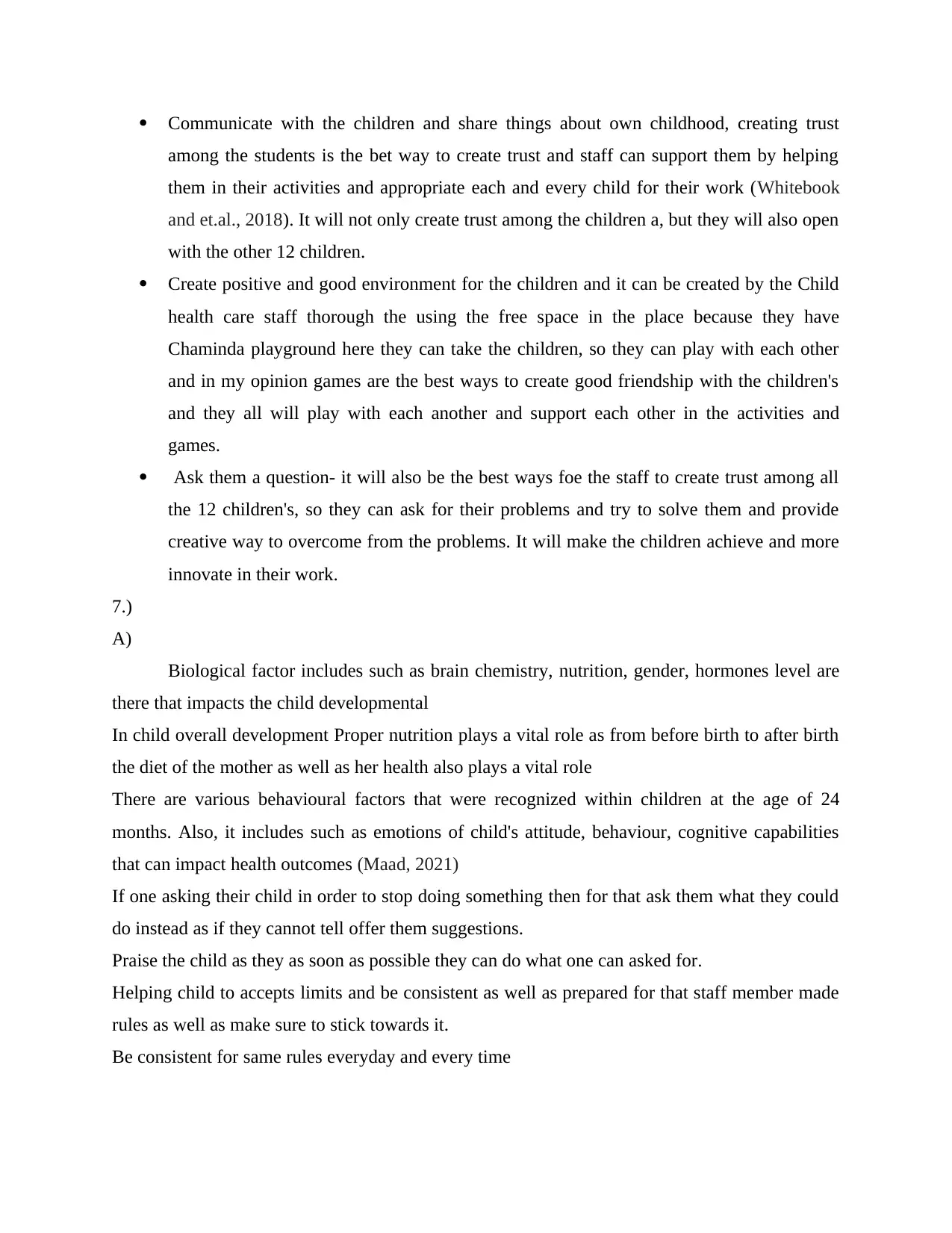
Communicate with the children and share things about own childhood, creating trust
among the students is the bet way to create trust and staff can support them by helping
them in their activities and appropriate each and every child for their work (Whitebook
and et.al., 2018). It will not only create trust among the children a, but they will also open
with the other 12 children.
Create positive and good environment for the children and it can be created by the Child
health care staff thorough the using the free space in the place because they have
Chaminda playground here they can take the children, so they can play with each other
and in my opinion games are the best ways to create good friendship with the children's
and they all will play with each another and support each other in the activities and
games.
Ask them a question- it will also be the best ways foe the staff to create trust among all
the 12 children's, so they can ask for their problems and try to solve them and provide
creative way to overcome from the problems. It will make the children achieve and more
innovate in their work.
7.)
A)
Biological factor includes such as brain chemistry, nutrition, gender, hormones level are
there that impacts the child developmental
In child overall development Proper nutrition plays a vital role as from before birth to after birth
the diet of the mother as well as her health also plays a vital role
There are various behavioural factors that were recognized within children at the age of 24
months. Also, it includes such as emotions of child's attitude, behaviour, cognitive capabilities
that can impact health outcomes (Maad, 2021)
If one asking their child in order to stop doing something then for that ask them what they could
do instead as if they cannot tell offer them suggestions.
Praise the child as they as soon as possible they can do what one can asked for.
Helping child to accepts limits and be consistent as well as prepared for that staff member made
rules as well as make sure to stick towards it.
Be consistent for same rules everyday and every time
among the students is the bet way to create trust and staff can support them by helping
them in their activities and appropriate each and every child for their work (Whitebook
and et.al., 2018). It will not only create trust among the children a, but they will also open
with the other 12 children.
Create positive and good environment for the children and it can be created by the Child
health care staff thorough the using the free space in the place because they have
Chaminda playground here they can take the children, so they can play with each other
and in my opinion games are the best ways to create good friendship with the children's
and they all will play with each another and support each other in the activities and
games.
Ask them a question- it will also be the best ways foe the staff to create trust among all
the 12 children's, so they can ask for their problems and try to solve them and provide
creative way to overcome from the problems. It will make the children achieve and more
innovate in their work.
7.)
A)
Biological factor includes such as brain chemistry, nutrition, gender, hormones level are
there that impacts the child developmental
In child overall development Proper nutrition plays a vital role as from before birth to after birth
the diet of the mother as well as her health also plays a vital role
There are various behavioural factors that were recognized within children at the age of 24
months. Also, it includes such as emotions of child's attitude, behaviour, cognitive capabilities
that can impact health outcomes (Maad, 2021)
If one asking their child in order to stop doing something then for that ask them what they could
do instead as if they cannot tell offer them suggestions.
Praise the child as they as soon as possible they can do what one can asked for.
Helping child to accepts limits and be consistent as well as prepared for that staff member made
rules as well as make sure to stick towards it.
Be consistent for same rules everyday and every time
Paraphrase This Document
Need a fresh take? Get an instant paraphrase of this document with our AI Paraphraser
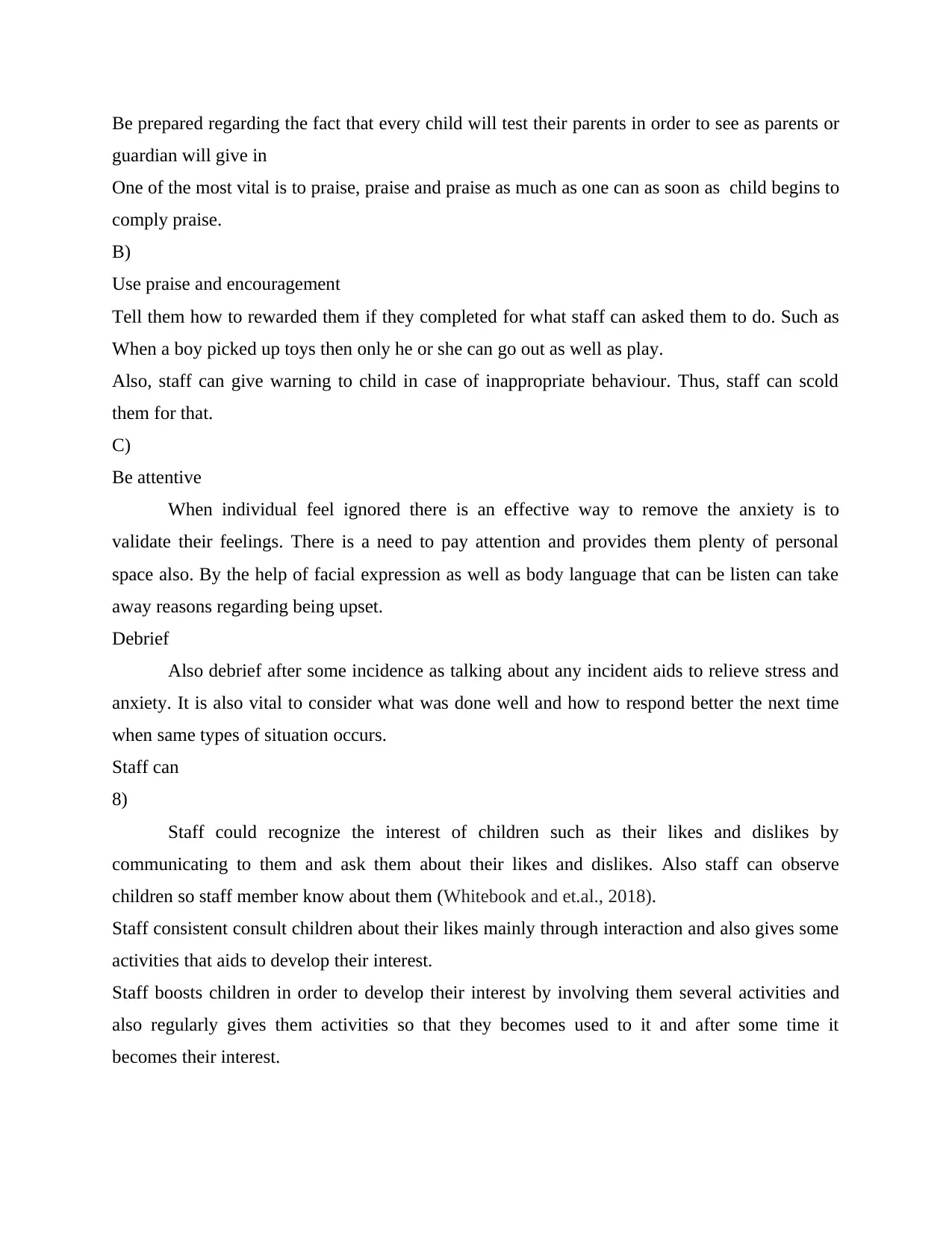
Be prepared regarding the fact that every child will test their parents in order to see as parents or
guardian will give in
One of the most vital is to praise, praise and praise as much as one can as soon as child begins to
comply praise.
B)
Use praise and encouragement
Tell them how to rewarded them if they completed for what staff can asked them to do. Such as
When a boy picked up toys then only he or she can go out as well as play.
Also, staff can give warning to child in case of inappropriate behaviour. Thus, staff can scold
them for that.
C)
Be attentive
When individual feel ignored there is an effective way to remove the anxiety is to
validate their feelings. There is a need to pay attention and provides them plenty of personal
space also. By the help of facial expression as well as body language that can be listen can take
away reasons regarding being upset.
Debrief
Also debrief after some incidence as talking about any incident aids to relieve stress and
anxiety. It is also vital to consider what was done well and how to respond better the next time
when same types of situation occurs.
Staff can
8)
Staff could recognize the interest of children such as their likes and dislikes by
communicating to them and ask them about their likes and dislikes. Also staff can observe
children so staff member know about them (Whitebook and et.al., 2018).
Staff consistent consult children about their likes mainly through interaction and also gives some
activities that aids to develop their interest.
Staff boosts children in order to develop their interest by involving them several activities and
also regularly gives them activities so that they becomes used to it and after some time it
becomes their interest.
guardian will give in
One of the most vital is to praise, praise and praise as much as one can as soon as child begins to
comply praise.
B)
Use praise and encouragement
Tell them how to rewarded them if they completed for what staff can asked them to do. Such as
When a boy picked up toys then only he or she can go out as well as play.
Also, staff can give warning to child in case of inappropriate behaviour. Thus, staff can scold
them for that.
C)
Be attentive
When individual feel ignored there is an effective way to remove the anxiety is to
validate their feelings. There is a need to pay attention and provides them plenty of personal
space also. By the help of facial expression as well as body language that can be listen can take
away reasons regarding being upset.
Debrief
Also debrief after some incidence as talking about any incident aids to relieve stress and
anxiety. It is also vital to consider what was done well and how to respond better the next time
when same types of situation occurs.
Staff can
8)
Staff could recognize the interest of children such as their likes and dislikes by
communicating to them and ask them about their likes and dislikes. Also staff can observe
children so staff member know about them (Whitebook and et.al., 2018).
Staff consistent consult children about their likes mainly through interaction and also gives some
activities that aids to develop their interest.
Staff boosts children in order to develop their interest by involving them several activities and
also regularly gives them activities so that they becomes used to it and after some time it
becomes their interest.
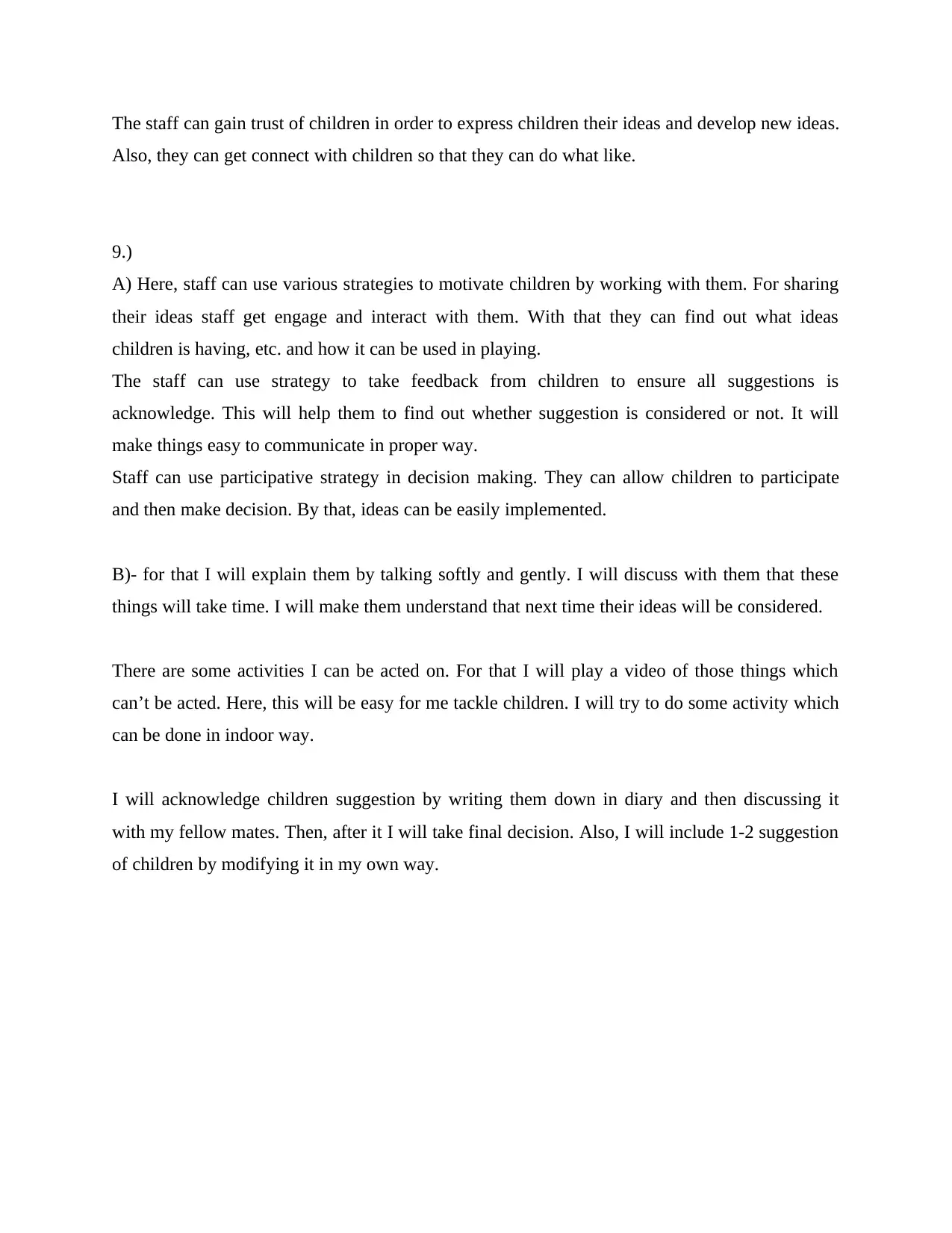
The staff can gain trust of children in order to express children their ideas and develop new ideas.
Also, they can get connect with children so that they can do what like.
9.)
A) Here, staff can use various strategies to motivate children by working with them. For sharing
their ideas staff get engage and interact with them. With that they can find out what ideas
children is having, etc. and how it can be used in playing.
The staff can use strategy to take feedback from children to ensure all suggestions is
acknowledge. This will help them to find out whether suggestion is considered or not. It will
make things easy to communicate in proper way.
Staff can use participative strategy in decision making. They can allow children to participate
and then make decision. By that, ideas can be easily implemented.
B)- for that I will explain them by talking softly and gently. I will discuss with them that these
things will take time. I will make them understand that next time their ideas will be considered.
There are some activities I can be acted on. For that I will play a video of those things which
can’t be acted. Here, this will be easy for me tackle children. I will try to do some activity which
can be done in indoor way.
I will acknowledge children suggestion by writing them down in diary and then discussing it
with my fellow mates. Then, after it I will take final decision. Also, I will include 1-2 suggestion
of children by modifying it in my own way.
Also, they can get connect with children so that they can do what like.
9.)
A) Here, staff can use various strategies to motivate children by working with them. For sharing
their ideas staff get engage and interact with them. With that they can find out what ideas
children is having, etc. and how it can be used in playing.
The staff can use strategy to take feedback from children to ensure all suggestions is
acknowledge. This will help them to find out whether suggestion is considered or not. It will
make things easy to communicate in proper way.
Staff can use participative strategy in decision making. They can allow children to participate
and then make decision. By that, ideas can be easily implemented.
B)- for that I will explain them by talking softly and gently. I will discuss with them that these
things will take time. I will make them understand that next time their ideas will be considered.
There are some activities I can be acted on. For that I will play a video of those things which
can’t be acted. Here, this will be easy for me tackle children. I will try to do some activity which
can be done in indoor way.
I will acknowledge children suggestion by writing them down in diary and then discussing it
with my fellow mates. Then, after it I will take final decision. Also, I will include 1-2 suggestion
of children by modifying it in my own way.
⊘ This is a preview!⊘
Do you want full access?
Subscribe today to unlock all pages.

Trusted by 1+ million students worldwide
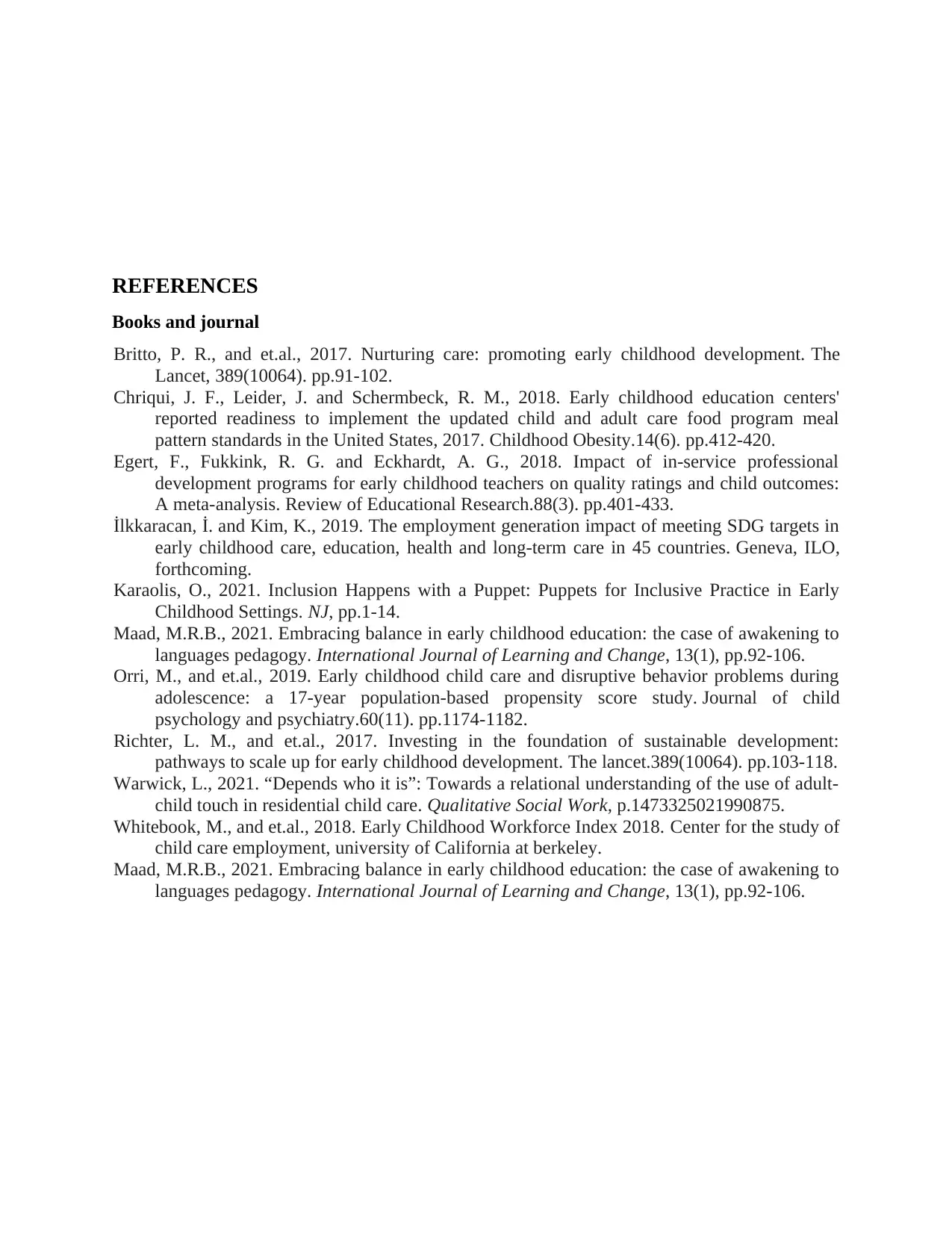
REFERENCES
Books and journal
Britto, P. R., and et.al., 2017. Nurturing care: promoting early childhood development. The
Lancet, 389(10064). pp.91-102.
Chriqui, J. F., Leider, J. and Schermbeck, R. M., 2018. Early childhood education centers'
reported readiness to implement the updated child and adult care food program meal
pattern standards in the United States, 2017. Childhood Obesity.14(6). pp.412-420.
Egert, F., Fukkink, R. G. and Eckhardt, A. G., 2018. Impact of in-service professional
development programs for early childhood teachers on quality ratings and child outcomes:
A meta-analysis. Review of Educational Research.88(3). pp.401-433.
İlkkaracan, İ. and Kim, K., 2019. The employment generation impact of meeting SDG targets in
early childhood care, education, health and long-term care in 45 countries. Geneva, ILO,
forthcoming.
Karaolis, O., 2021. Inclusion Happens with a Puppet: Puppets for Inclusive Practice in Early
Childhood Settings. NJ, pp.1-14.
Maad, M.R.B., 2021. Embracing balance in early childhood education: the case of awakening to
languages pedagogy. International Journal of Learning and Change, 13(1), pp.92-106.
Orri, M., and et.al., 2019. Early childhood child care and disruptive behavior problems during
adolescence: a 17‐year population‐based propensity score study. Journal of child
psychology and psychiatry.60(11). pp.1174-1182.
Richter, L. M., and et.al., 2017. Investing in the foundation of sustainable development:
pathways to scale up for early childhood development. The lancet.389(10064). pp.103-118.
Warwick, L., 2021. “Depends who it is”: Towards a relational understanding of the use of adult-
child touch in residential child care. Qualitative Social Work, p.1473325021990875.
Whitebook, M., and et.al., 2018. Early Childhood Workforce Index 2018. Center for the study of
child care employment, university of California at berkeley.
Maad, M.R.B., 2021. Embracing balance in early childhood education: the case of awakening to
languages pedagogy. International Journal of Learning and Change, 13(1), pp.92-106.
Books and journal
Britto, P. R., and et.al., 2017. Nurturing care: promoting early childhood development. The
Lancet, 389(10064). pp.91-102.
Chriqui, J. F., Leider, J. and Schermbeck, R. M., 2018. Early childhood education centers'
reported readiness to implement the updated child and adult care food program meal
pattern standards in the United States, 2017. Childhood Obesity.14(6). pp.412-420.
Egert, F., Fukkink, R. G. and Eckhardt, A. G., 2018. Impact of in-service professional
development programs for early childhood teachers on quality ratings and child outcomes:
A meta-analysis. Review of Educational Research.88(3). pp.401-433.
İlkkaracan, İ. and Kim, K., 2019. The employment generation impact of meeting SDG targets in
early childhood care, education, health and long-term care in 45 countries. Geneva, ILO,
forthcoming.
Karaolis, O., 2021. Inclusion Happens with a Puppet: Puppets for Inclusive Practice in Early
Childhood Settings. NJ, pp.1-14.
Maad, M.R.B., 2021. Embracing balance in early childhood education: the case of awakening to
languages pedagogy. International Journal of Learning and Change, 13(1), pp.92-106.
Orri, M., and et.al., 2019. Early childhood child care and disruptive behavior problems during
adolescence: a 17‐year population‐based propensity score study. Journal of child
psychology and psychiatry.60(11). pp.1174-1182.
Richter, L. M., and et.al., 2017. Investing in the foundation of sustainable development:
pathways to scale up for early childhood development. The lancet.389(10064). pp.103-118.
Warwick, L., 2021. “Depends who it is”: Towards a relational understanding of the use of adult-
child touch in residential child care. Qualitative Social Work, p.1473325021990875.
Whitebook, M., and et.al., 2018. Early Childhood Workforce Index 2018. Center for the study of
child care employment, university of California at berkeley.
Maad, M.R.B., 2021. Embracing balance in early childhood education: the case of awakening to
languages pedagogy. International Journal of Learning and Change, 13(1), pp.92-106.
Paraphrase This Document
Need a fresh take? Get an instant paraphrase of this document with our AI Paraphraser

1 out of 11
Related Documents
Your All-in-One AI-Powered Toolkit for Academic Success.
+13062052269
info@desklib.com
Available 24*7 on WhatsApp / Email
![[object Object]](/_next/static/media/star-bottom.7253800d.svg)
Unlock your academic potential
Copyright © 2020–2025 A2Z Services. All Rights Reserved. Developed and managed by ZUCOL.





